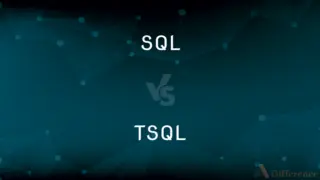Web-DL vs. Blu-ray — What's the Difference?
By Tayyaba Rehman & Maham Liaqat — Published on February 27, 2024
Web-DL is a digital file sourced directly from online streaming services, offering convenience and immediate availability, whereas Blu-ray delivers superior audio and video quality with physical ownership but requires a player.

Difference Between Web-DL and Blu-ray
Table of Contents
ADVERTISEMENT
Key Differences
Web-DL refers to content downloaded directly from online streaming platforms, encapsulating movies and TV shows in their digital format. This method ensures that the content is untouched by additional compression, often resulting in a clean, crisp viewing experience that is immediately accessible. In contrast, Blu-ray discs are physical media known for their high-definition video and audio quality, surpassing most digital downloads and streaming services in terms of fidelity and depth.
One of the main advantages of Web-DL is its convenience. Users can access content from anywhere, on any device that supports the streaming service, without the need for physical media or a Blu-ray player. Blu-ray, however, offers a tactile experience of ownership and often includes bonus features, director's commentaries, and behind-the-scenes content that digital formats typically lack.
Blu-ray's superiority in audio and video quality is largely due to its higher bitrates and storage capacity, which allow for less compression and more detail in the picture and sound. This is particularly noticeable on larger screens or in home theater setups. Web-DL, while still offering HD content, may not reach the same quality peaks due to limitations in streaming bandwidth or the original file's compression.
The choice between Web-DL and Blu-ray might also depend on the viewer's preference for physical versus digital collections. Blu-ray enthusiasts often cite the appeal of displaying their collections and the resale value of physical discs, whereas digital collectors appreciate the minimalism and ease of accessing their library without physical clutter.
Despite their differences, both formats have their place in the home entertainment landscape. Web-DL caters to the immediate, convenient consumption of content, whereas Blu-ray serves those who prioritize quality and value the tangibility and extra features of physical media.
ADVERTISEMENT
Comparison Chart
Source
Online streaming services
Physical disc
Quality
High-definition, subject to original compression
Higher bitrates, superior audio and video fidelity
Convenience
Immediate access, no physical player required
Requires a Blu-ray player, physical storage
Features
Generally limited to the main content
Often includes extras like commentary, deleted scenes
Ownership
Digital license, dependent on service availability
Physical ownership, can be resold
Compare with Definitions
Web-DL
A digital version of a movie or TV show downloaded directly from streaming services.
The latest movie was available as a Web-DL the day after its streaming release.
Blu-ray
Often includes special features and bonus content.
The Blu-ray edition came with exclusive behind-the-scenes footage.
Web-DL
Offers convenience and quick access.
I prefer Web-DL for watching movies without leaving home.
Blu-ray
Known for superior video and audio quality.
Blu-ray's audiovisual quality surpasses standard streaming services.
Web-DL
Subject to the quality of the original stream.
The Web-DL quality varies depending on the service's compression.
Blu-ray
A high-definition physical media format for movies and TV shows.
I bought the complete series on Blu-ray for the ultimate viewing experience.
Web-DL
Dependent on internet and service availability.
My favorite series is only available as a Web-DL on specific platforms.
Blu-ray
Requires a Blu-ray player.
Our home theater setup includes a state-of-the-art Blu-ray player.
Web-DL
No physical storage required.
My Web-DL collection fits on my hard drive, saving shelf space.
Blu-ray
Represents a tangible collection.
My Blu-ray collection is a centerpiece of my living room.
Common Curiosities
Can Web-DL content be played on any device?
Yes, Web-DL content can be played on any compatible device that supports the file format.
Is there a difference in ownership between Web-DL and Blu-ray?
Yes, Blu-ray offers physical ownership and can be resold, while Web-DL provides a digital license tied to service availability.
What is Web-DL?
Web-DL is a digital file downloaded from streaming services, offering HD content without additional compression.
What are the advantages of Web-DL?
Web-DL offers convenience, immediate access, and does not require physical storage or a player.
What distinguishes Blu-ray in terms of quality?
Blu-ray discs provide superior audio and video quality due to higher bitrates and less compression.
Do Blu-ray discs require a special player?
Yes, Blu-ray discs require a specific Blu-ray player to view the content.
How does streaming bandwidth affect Web-DL quality?
Limited streaming bandwidth can affect the quality of Web-DL, potentially leading to lower resolution or compression artifacts.
Can Web-DL match Blu-ray in audiovisual fidelity?
While Web-DL offers HD quality, it generally does not match the high bitrate audio and video fidelity of Blu-ray.
Is internet required for watching Web-DL?
Internet is required for downloading Web-DL content, but not for playback once downloaded.
Can Web-DL versions of movies be available before Blu-ray releases?
Yes, Web-DL versions can be available shortly after or even before the theatrical release, often preceding Blu-ray releases.
What additional content does Blu-ray offer?
Blu-ray often includes bonus features, such as director's commentaries and deleted scenes, not available with Web-DL.
Why might someone prefer Blu-ray over Web-DL?
Individuals might prefer Blu-ray for its unmatched quality, physical collection aspect, and extra features.
How do Blu-ray and Web-DL compare in terms of environmental impact?
Blu-ray discs have a physical production and shipping footprint, whereas Web-DL's impact comes from data center energy use.
What is the future outlook for Blu-ray and Web-DL?
While Blu-ray remains popular among enthusiasts for its quality, the convenience and growing quality of Web-DL suggest a digital-focused future.
What is the storage requirement for Blu-ray?
Blu-ray requires physical storage space for the discs, as opposed to digital storage for Web-DL.
Share Your Discovery

Previous Comparison
Bond Moment vs. Dipole Moment
Next Comparison
SQL vs. TSQLAuthor Spotlight
Written by
Tayyaba RehmanTayyaba Rehman is a distinguished writer, currently serving as a primary contributor to askdifference.com. As a researcher in semantics and etymology, Tayyaba's passion for the complexity of languages and their distinctions has found a perfect home on the platform. Tayyaba delves into the intricacies of language, distinguishing between commonly confused words and phrases, thereby providing clarity for readers worldwide.
Co-written by
Maham Liaqat












































